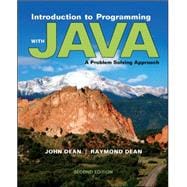The second edition adds new language features and end-of-chapter GUI sections that include animation. New chapters include an introduction to the Java Collections Framework and an in-depth treatment of recursion. Two new supplementary chapters on the book’s companion website describe the JavaFX GUI platform.
Before diving into object-oriented programming (OOP) in Chapter 6, the second edition includes a “mini-chapter” that describes how to write multiple-method programs in a non-OOP environment. Those who want to continue this theme can follow an optional “late objects” approach by reading two chapters on the book’s website before returning to OOP in Chapter 6. Some key features include:
• A conversational, easy-to-follow writing style.
• Simple GUI programming early, in an optional standalone graphics track.
• Well-identified alternatives for altering the book's sequence to fit individual needs.
• Well-developed projects in six different academic disciplines, with a handy summary.
• Detailed customizable PowerPointTM lecture slides, with icon-keyed hidden notes.
I have used the Dean and Dean book in my Introduction to Java Programming class for the past year. This is an excellent text and I am very happy with it. It is the only text that I have ever used that always gets positive comments from students on my class evaluations even though there is no question asked about the text. The chapters are well thought out and the coverage is complete. The progression from topic-to-topic is masterful, and the writing is exceptionally clear and at the perfect level for an introductory Java class.
– Ralph Duffy, South Seattle Community College








